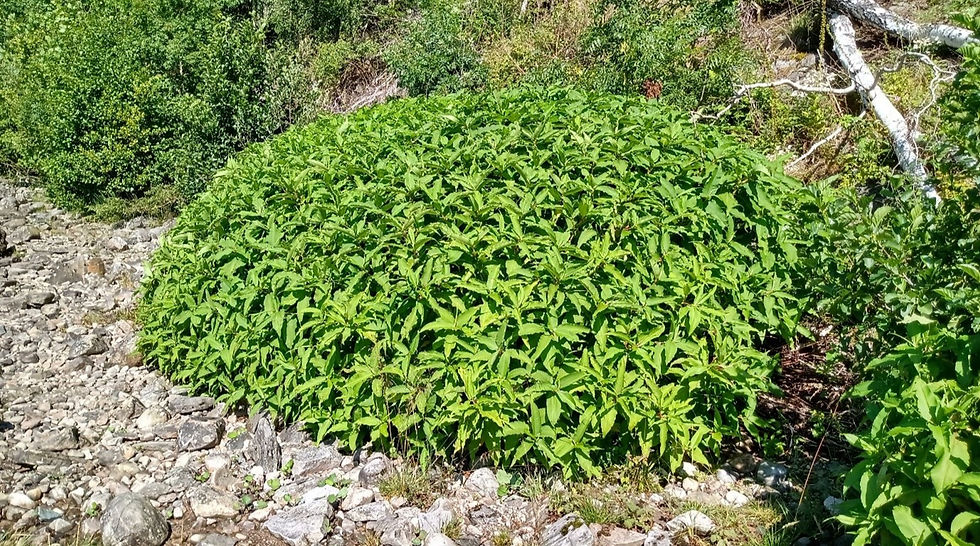Invasive Non-Native Species Week 2022
- ERS Remediation

- May 23, 2022
- 4 min read
Updated: May 12, 2023
This year for Invasive Species Week we are looking at some of the less well-known invasive species which are spreading across the UK. Many people have heard of more common invasive weeds like Japanese Knotweed or Himalayan Balsam, but what about Few Flowered Leek or Curly Waterweed? There are many other “Schedule 9” plants spreading in the wild and affecting native flora and fauna across the UK. Here are some our Invasive Weeds Team wanted to discuss:
Few Flowered Leek

Few Flowered Leek (also known as Few Flowered Garlic) is a Central Asian wild onion, now found in woodland areas, riverbanks, and hedgerows across the UK. It flowers March through April and produces multiple bulbils which are easily spread by grazing animals and human activity, or transported by water.
It’s fast-growing and out-competes native species, such as native wild garlic which it closely resembles. It is best treated in Spring before bulbils (bulb shaped buds) are produced. It can be challenging to remediate, however a site-specific management plan including appropriate bio security measures can offer good results.
American Skunk Cabbage

Native to North America as its name suggests, American Skunk Cabbage was introduced to the UK in the 20th century. It’s easily identified by its rosette of large leathery green leaves and yellow hood-like flowers, which have a strong skunk odour, giving the plant its name.
American Skunk Cabbage forms dense stands in wet, muddy areas surrounding ponds, streams and marshy woodlands, and can outcompete many of the sensitive native species growing in these habitats.
There are a range of remediation options available to treat American Skunk Cabbage, including options for environmentally sensitive area.
Giant Rhubarb

Giant Rhubarb is a large, clump-forming, long living plant native to South America. It is commonly found growing in damp or wet areas, and within shaded areas along the edges of ponds, streams and drains.
Its 2m wide umbrella-like leaves block out sunlight which can prevent native plants from growing. In Autumn, the cone-like flowers produce an amazing 250,000 seeds! Then when the plants then die back in winter, it can make the exposed riverbanks vulnerable to erosion.
Giant Rhubarb can be treated using conventional methods, but in environmentally sensitive locations, removing the seed heads is an alternative. Similar to Japanese Knotweed, it has rhizomes which can regenerate into a new plant so care needs to be taken with contaminated soil to avoid spreading it.
Rhododendron Ponticum

Rhododendron ponticum has two geographically distinct native ranges south of the Black Sea and in Spain/Portugal. It was introduced to the UK as a decorative plant in the 18th century and today it is found across the UK on moorlands, woodlands, hillsides and riverbanks, as well as in gardens and parks.
It has leathery, dull green leaves and light, woody stems. Mature plants can reach 8m in height and produce pink to purple clumps of flowers between May and June. It produces large quantities of viable seeds which then form a persistent seed bank for many years.
It can be treated by physically removing the plants and treating remaining stumps, but other treatment options are available for harder to reach areas. An ongoing management plan is important until the seed bank is depleted.
Curly Waterweed

Curly waterweed is an aquatic plant originating from South America. Despite being listed as an invasive plant, it is still widely sold in aquatics shops across the UK as an oxygenating pond plant – although in areas of dense growth it can actually reduce oxygen levels and harm aquatic life.
It has strongly curved dark green leaves in a spiral arrangement and can grow in water up to 6m deep. It reproduces by fragmentation – detached stems sink and root, establishing new growth. It grows in dense strands in slow moving water bodies like canals, impeding water flow and blocking out light, outcompeting native plants.
Remediation can be difficult, due to the way the plant spreads by fragmentation and the negative effect herbicide control might have on native plants. However, it can be controlled with an appropriate site-specific treatment and management plan. Any machinery, equipment and clothing must be checked for plant fragments before leaving the site.
Himalayan Knotweed

Himalayan knotweed originates from Central Asia and was introduced into the UK in 1900 as an ornamental plant. It was first recorded in the wild in 1917 and has become a very persistent invasive non-native species.
Seed production is rare in the UK but it can spreads through its complex rhizome root systems or by pieces of stems containing nodes. The rhizome root system can reach several metres causing a stand of HK to increase in area size rapidly. Rhizome and stem fragments can be spread and dispersed by natural means e.g. watercourses, flooding, or by human interaction e.g. garden waste, fly-tipping or movement of contaminated soils.
It can reach 2m in height during one growing season, forming dense thickets of reddish-brown, hollow, bamboo-like stems with fine white hairs. It has slender green leaves which taper to a long point and produces small white or pale pink flowers in loose clusters from August.
Throughout the dormant season stems remain visible, turning various shades of brown until the new growing season returns when the cycle begins again. The decomposing old stems and the canopy of the growing plants poses a highly competitive edge reducing the growth of our native species.

For more information on these invasive weeds and the many others that ERS are experienced at treating, take a look at our Invasive Weeds page. Or if you think you have one of these invasive weeds growing on your land, site or property and would like more information about our treatment options and management plans, get in touch and ask to speak to our Invasive Weeds Team.






Comments